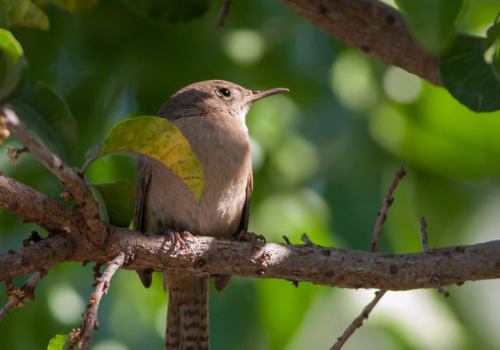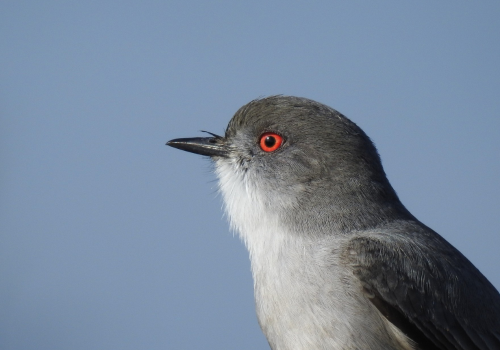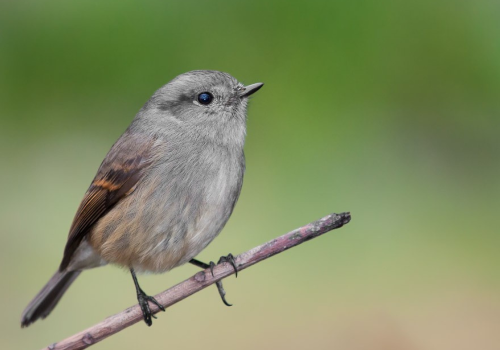| Storm-petrels (birds from the families Oceanitidae and Hydrobatidae) are small and pelagic seabirds, which live mainly offshore, visiting land just for breeding.
There are four storm-petrels which are regular in pelagic waters off northern Chile, and could breed here: Elliot’s storm-petrel (Oceanites gracilis), Wedge-rumped storm-petrel (Oceanodroma tethys), Markham’s storm-petrel (Oceanodroma markhami) and Hornby’s Storm-petrel (Oceanodroma hornbyi). Although they’re regularly seen in Chile, their breeding biology is almost unknown. The Elliot’s storm-petrel is an abundant seabird in their distribution. However, just one breeding site is know in the Chungungo Islet (provincia de Elqui, Chile). At this islet, just a few nests have been recorded (Marín & Schlater 1983; Hertel & Torres-Mura 2003). On the other hand, the Wedge-rumped storm-petrel breeds in the Galapagos Archipelago (O. t. tethys) and in some islands of Peru (O. t. kelsalli). In Chile, just one site have been reported, in Isla Grande, Atacama (Bernal et al. 2006). In the case of Markham’s storm-petrel, just one colony was known in the last decades in Paracas, Peru, with 2000-4000 breeding pairs (Jahncke 1993), and just recently one breeding site was reported near Arica, Chile (Torres-Mura & Lemus 2013). Before the discoveries of our project, nothing was known about the breeding sites of the Hornby’s storm-petrel, but the fledgling’s falling between Arica and Antofagasta suggested that the species was breeding in the surroundings. Elliot’s, Markham’s and Hornby’s storm-petrels are classified as “Data Deficient” by the IUCN, because the lack of knowledge on their breeding sites and their breeding population. Because of that, Birdlife International proposed as an prioritary conservation action for these species, the search of their breeding grounds. In the Chilean case, the situation is similar, but the Markham’s storm-petrel was classified as “Endangered”, because of the few breeding colonies known, and the mortality of fledglings provocated by the light pollution and the destruction of their breeding habitat. Starting with the first Breeding Bird Atlas of Chile, our NGO led the challenge of finding the breeding colonies of these species, from Arica y Parinacota, at the northern tip of Chile, to Atacama region, about 900 km south. The main project objectives are:
ResultsSince 2013, more than 20 field expeditions have been made within Arica y Parinacota, Tarapacá, Antofagasta y Atacama, with important results, discovering several new breeding colonies. For Markham’s storm-petrel, we discovered the world’s largest breeding site in Arica y Parinacota Region, plus three sites near Iquique and one in Antofagasta. These breeding sites are located at least at 20 kilometers from the coast. If you are interested in more information, we recommend you to read these articles in Neotropical Birding and Ardea, and this note in the webpage of American Bird Conservancy (ABC). With these discoveries, we have new challenges and opportunities for this species’ protection. In 2017, we discovered the world’s first breeding colony of Hornby’s storm Petrel near Diego de Almagro (Atacama Region), at 70 kilometers from the coast (read here the article). More recently, we found scattered nests near Iquique and Antofagasta, reported (in spanish) here. With the discovery of new colonies, we realized that these species have multiple current and potential threats: light pollution causes several thousands of Markham’s storm-petrel die every year (which gives them the lamentable record of the most-affected seabird in the world by this cause), military exercises destroy the colonies of the same species, garbage locks the entrances of the cavities where this species breeds, and mining and energetic projects threatens to be builded on the colonies of both species. Furthermore, the main cities are changing the lights, using white LED, which attracts more birds. Nowadays, we’re working with the Chilean Environmental Ministry to address the threats for these species. Currently, we are defining possible places to create the first protected areas in some of the known breeding colonies, and we are initiating short and long term initiatives to reduce the light pollution in critical sectors for the storm-petrels. At the same time, we are working with the local authorities and the community to let them know this important conservation problem. You may read this report published in The Atlantic, where the history of our project was telled. PartnersDuring 2014 and 2015, our searching was funded by the Western Alliance for Nature (WAN Conservancy). From 2016, the population estimation, the impacts assessing and the protection actions have been adviced by American Bird Conservancy (ABC) and Oikonos. We are grateful with Mohammed Bin Zayed Conservation Fund and the Packard Foundation who granted our work in 2018. During 2019, the Bioacoustic Research Program (BRP) from the Cornell University gave us three Swifts for obtaining the first recording of Hornby’s storm-petrel. Furthermore, the Neotropical Bird Club through their Conservation fund, funded our field work, looking for new breeding colonies of storm-petrels. The Pacific Seabird Group through their Craig Harrison Conservation Fund, funded some actions for reducing the light pollution in Arica and Iquique. American Bird Conservancy (ABC) continued supporting our work, in protecting the breeding sites. Getting involvedAlthough we’ve made several discoveries, our current knowledge of these small seabirds is very limited. Finding new colonies, learning more about their breeding biology, identifying the flying routes between the ocean and the colonies, are crucial to guide conservation efforts. The design and implementation of conservation actions is a complex endeavor, involving many public and private actors, including salt mines, renewable energies developers, ports, municipalities, military, and also the communities in northern Chile cities, among others. If you are interested in supporting this project, write us to proyectogolondrinas@redobservadores.cl |
TEAMProject leaders: Rodrigo Silva, Fernando Medrano, Rodrigo Barros. DOCUMENTS
CONTACTMail: proyectogolondrinas@redobservadores.cl GALLERY[Best_Wordpress_Gallery id=”11″ gal_title=”Proyecto Golondrinas del desierto”] [rev_slider alias=”patrocinadores”] |
|---|
Atacama Storm-petrels project
- MÁS ARTICULOS



